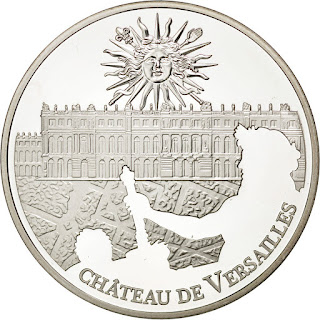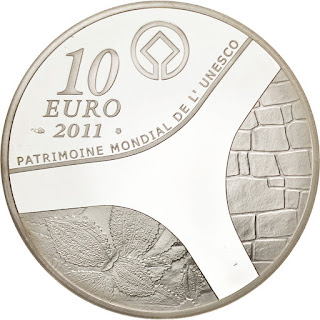France 10 Euro Silver Coin 2011 UNESCO Palace of Versailles
Commemorative issue: Palace of Versailles
Launched in 2007 with the Great Wall of China, the UNESCO World Heritage Site series is an opportunity for Monnaie de Paris to travel the world. In 2011, the series stops over in France to pay homage to one of the country’s most prestigious structures: the Palace of Versailles, which was the residence of kings Louis XIV, Louis XV and Louis XVI. A symbol of royal power and the influence of French culture in the 18th century, with 67,000 sq. m, 900 rooms, 93 hectares of gardens and 10 million visitors, this site is now the most visited in France and one of the most well known sites in the world. The site has taken a decisive step into modernity over the past few years, hosting exhibitions of works by contemporary artists Jeff Koons in 2008, Xavier Veilhans in 2009 and Takashi Murakami in 2010.
Obverse: The facade of the Palace of Versailles is featured prominently on the obverse. An ornate and radiant anthropomorphized sun — the symbol of King Louis XIV — hangs over the palace. Beneath the palace are the French-style gardens and a profile of Neptune is in the foreground, with the inscription "CHÂTEAU DE VERSAILLES" around the bottom rim.
Reverse: The reverse is divided into three sections. The first (top left) section carries the denomination, year-date, the World Heritage logo, and the motto "PATRIMOINE MONDIAL DE L'UNESCO," or "World Heritage of UNESCO." The bottom section is filled by a floral pattern and honours natural heritage as symbolized by flora, while the right section is occupied by a stone-brick background and honours architectural heritage. The blank Y-shape field that divides these sections is an overhead view of the UNESCO building's Paris headquarters.
Lettering: 10 EURO 2011 PATRIMOINE MONDIAL DE L'UNESCO
Edge Smooth
Metal Silver (.900)
Weight 22.2 g
Diameter 37 mm
Shape Round
The 2011 10 Euro Silver Proof UNESCO Palace of Versailles coin comes from Le Monnaie de Paris, or the Paris Mint. Containing 0.6424 troy oz ASW (actual silver weight), this coin pays tribute to UNESCO World Heritage, a United Nations organization aimed at preserving culture around the globe. This 0.900 fine silver coin is legal tender worth 10 Euro in the European Union.
France has long been active in the United Nations Educational, Scientific, and Cultural Organization (UNESCO), ratifying its adherence to the World Heritage Convention in the year of the organization's inception, 1975. Known for its acute treatment of aesthetics, art, and cultural refinement, France has historically been a world leader in the advancement of science and culture. As an iconic hallmark of French architecture, Versailles is a fitting example of this cultural initiative. The palace is even more pleasing in proof finish.
Palace of Versailles
Palace of Versailles, former French royal residence and centre of government, now a national landmark. It is located in the city of Versailles, Yvelines département, Île-de-France région, northern France, 10 miles (16 km) west-southwest of Paris. As the centre of the French court, Versailles was one of the grandest theatres of European absolutism.
The original residence, built from 1631 to 1634, was primarily a hunting lodge and private retreat for Louis XIII (reigned 1610–1643) and his family. Under the guidance of Louis XIV (1643–1715), it was transformed (1661–1710) into an immense and extravagant complex surrounded by stylized English and French gardens; every detail of its construction glorified the king. The additions were designed by such renowned architects as Jules Hardouin-Mansart, Robert de Cotte, and Louis Le Vau. Charles Le Brun oversaw the interior decoration. Landscape artist André Le Nôtre created symmetrical French gardens that included ornate fountains with “magically” still water, expressing the power of humanity — and, specifically, the king — over nature.
Declared the official royal residence in 1682 and the official residence of the court of France on May 6, 1682, the Palace of Versailles was abandoned after the death of Louis XIV in 1715. In 1722, however, it was returned to its status as royal residence. Further additions were made during the reigns of Louis XV (1715–1774) and Louis XVI (1774–1792). Following the French Revolution of 1789, the complex was nearly destroyed; it was subsequently restored by Louis-Philippe (1830–1848), but its utility gradually decreased. By the 20th century, though it was occasionally used for plenary congresses of the French parliament or as housing for visiting heads of state, the primary utility of the palace lay in tourism.
Among the most famous rooms in the palace are the Galerie des Glaces (Hall of Mirrors; 1678–1689) and the other Grands Appartements (State Rooms). The former is characterized by 17 wide, arcaded mirrors opposite 17 windows; glass chandeliers hang from its arched, ornately painted ceiling, and gilded statues and reliefs border its walls. The hall is flanked on opposite ends by the equally striking Salon de la Paix (Salon of Peace) and Salon de la Guerre (Salon of War). It was in the Galerie des Glaces that the Treaty of Versailles was signed by the Allies and Germany in 1919. Other important sites are the Grand Trianon (1678–1688) and the late 18th-century Petit Trianon, which were built as private residences for the royal family and special guests. The Museum of French History, founded in 1837 during the period of restoration overseen by Louis-Philippe, was consecrated “to all the glories of France”; however, its 6,000 paintings and 2,000 sculptures are largely closed to the public.
UNESCO designated the palace and its gardens a World Heritage site in 1979. Following a devastating winter storm in 1989, which destroyed more than 1,000 trees on the palace grounds, the French government initiated a wide-ranging project of repair and renovation. A severe windstorm in 1999 caused the loss of some 10,000 trees, including several planted by Marie Antoinette and Napoleon Bonaparte. The château was also damaged. In the late 1990s some nine million people visited the palace annually.

